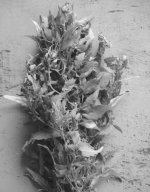Here are a couple more papers on phytoplasma in Cannabis. Sorry if they have already been posted.
‘Candidatus Phytoplasma asteris’ (group 16SrI) associated with a witches’-broom disease of Cannabis sativa in India
WITCHE'S BROOM AND PHYLLODY LIKE SYMPTOMS OF DISEASES IN Acalypha indica L. AND
Cannabis sativa L. -A NEW REPORT FROM CHAMPARAN, NORTH BIHAR
Check out this awesome pic from the second one, wow that is Witches' Broom like a big dog!

‘Candidatus Phytoplasma asteris’ (group 16SrI) associated with a witches’-broom disease of Cannabis sativa in India
WITCHE'S BROOM AND PHYLLODY LIKE SYMPTOMS OF DISEASES IN Acalypha indica L. AND
Cannabis sativa L. -A NEW REPORT FROM CHAMPARAN, NORTH BIHAR
Check out this awesome pic from the second one, wow that is Witches' Broom like a big dog!



